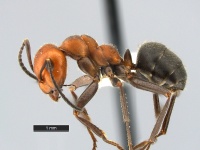Formica planipilis
| Formica planipilis | |
|---|---|

| |
| Scientific classification | |
| Kingdom: | Animalia |
| Phylum: | Arthropoda |
| Class: | Insecta |
| Order: | Hymenoptera |
| Family: | Formicidae |
| Subfamily: | Formicinae |
| Tribe: | Formicini |
| Genus: | Formica |
| Species group: | rufa |
| Species: | F. planipilis |
| Binomial name | |
| Formica planipilis Creighton, 1940 | |
These ants nest in the soil, usually with some thatching of pine needles, but may also be found nesting in rotten logs and stumps in rocky and gravely soils. Brood and reproductives were found in nests from late June to mid August. Workers forage up into the canopy of pine trees. (Mackay and Mackay 2002)
Identification
The tentorial pit of this species is shallow. The middle and hind tibiae have a double row of bristles on the flexor surface, but each is with few hairs (fewer than 10 hairs in each row). There are a few scattered hairs on the other surfaces of the tibiae. The head of the major is longer than broad; the erect hairs on the mesosoma are short and of about equal length. The hairs on the head are longer and sparser than those on the mesosoma. (Mackay and Mackay 2002) This species is very similar to Formica obscuripes and may be synonymous with it (James Trager, pers. comm.).
Keys including this Species
Distribution
Canada; Alberta, British Columbia. United States: Washington to North Dakota, south through Nevada, New Mexico, Colorado and Kansas.
Latitudinal Distribution Pattern
Latitudinal Range: 50.72° to 33.6°.
| North Temperate |
North Subtropical |
Tropical | South Subtropical |
South Temperate |
- Source: AntMaps
Distribution based on Regional Taxon Lists
Nearctic Region: Canada, United States (type locality).
Distribution based on AntMaps
Distribution based on AntWeb specimens
Check data from AntWeb
Countries Occupied
| Number of countries occupied by this species based on AntWiki Regional Taxon Lists. In general, fewer countries occupied indicates a narrower range, while more countries indicates a more widespread species. |

|
Estimated Abundance
| Relative abundance based on number of AntMaps records per species (this species within the purple bar). Fewer records (to the left) indicates a less abundant/encountered species while more records (to the right) indicates more abundant/encountered species. |

|
Habitat
In New Mexico (Mackay and Mackay 2002) - Grasslands, open forests, ponderosa pine forests, often found in riparian areas, popular-spruce forests, up to about 3000 meters elevation.
Biology
Nevada, Wheeler and Wheeler (1986) - Our 46 records are widely scattered throughout the state and represent 29 localities; 4,800-10,200 ft. (75% from 6,000-9,000 ft.). Five records were from the Cool Desert, 3 from the Pinyon-Juniper Biome, and 4 from the Coniferous Forest Biome. F. planipilis makes extensive use of thatch. Most of our nests were typical domes averaging 53 cm in diameter and 28 cm in height; a soil base 76 cm in diameter was recorded in two instances. Nest material: grass culms in pieces 5 cm long, juniper sprays, pine needles. Atypical nests: 1 under log lying on ground, 1 in log, 1 with thatch spread along a log 60 cm in diameter and 1.8 m long, I with thatch surrounding a crack in a rock.
Nest site selected in open areas devoid of cover. Nest begun at the base of some small plant (frequently sagebrush). Extensive use made of thatching. The finished nest consisting of a large mound of collected detritus. (Creighton, 1940)
Castes
Worker
    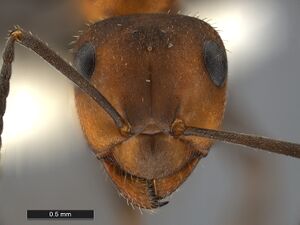 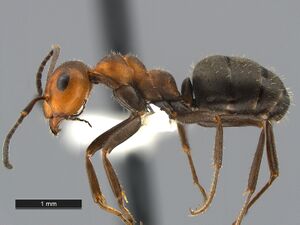 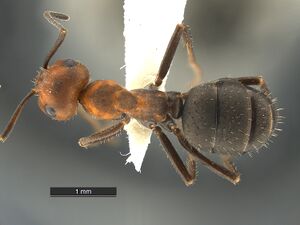 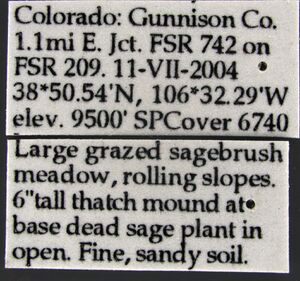
| |
| . | Owned by Museum of Comparative Zoology. |
Images from AntWeb
   
| |
| Worker. Specimen code casent0103374. Photographer April Nobile, uploaded by California Academy of Sciences. | Owned by USNM, Washington, DC, USA. |
   
| |
| Worker. Specimen code casent0103375. Photographer April Nobile, uploaded by California Academy of Sciences. | Owned by USNM, Washington, DC, USA. |
   
| |
| Worker. Specimen code casent0105753. Photographer April Nobile, uploaded by California Academy of Sciences. | Owned by USNM, Washington, DC, USA. |
   
| |
| Worker. Specimen code casent0103234. Photographer April Nobile, uploaded by California Academy of Sciences. | Owned by USNM, Washington, DC, USA. |
Queen
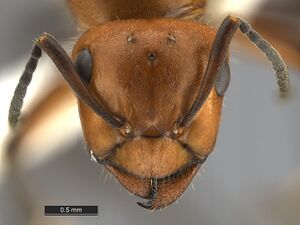 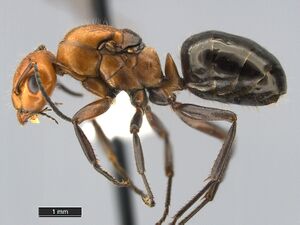 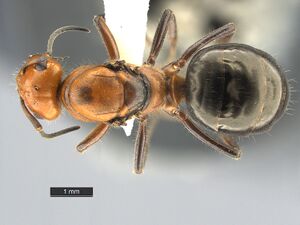 
| |
| . | |
Nomenclature
The following information is derived from Barry Bolton's Online Catalogue of the Ants of the World.
- planipilis. Formica rufa subsp. planipilis Creighton, 1940a: 9, fig. 1 (w.) U.S.A. Cole, 1956f: 259 (q.). Subspecies of integroides: Creighton, 1950a: 490. Raised to species: Cole, 1956f: 259.
Description
References
- Cole, A. C., Jr. 1956g. Studies of Nevada ants. IV. Descriptions of sexual castes of three members of the rufa group of the genus Formica L. J. Tenn. Acad. Sci. 31: 257-260. (page 259, queen described, raised to species)
- Creighton, W. S. 1940a. A revision of the North American variants of the ant Formica rufa. American Museum Novitates 1055: 1-10. (page 9, worker described)
- Creighton, W. S. 1950a. The ants of North America. Bulletin of the Museum of Comparative Zoology 104: 1-585 (page 490, subspecies of integroides)
- Mackay, W. P. and E. Mackay. 2002. The ants of New Mexico (Hymenoptera: Formicidae). Edwin Mellen Press, Lewiston, NY.
- Wheeler, G. C. and J. Wheeler. 1986. The ants of Nevada. Natural History Museum of Los Angeles County, Los Angeles.
References based on Global Ant Biodiversity Informatics
- Browne J. T., R. E. Gregg. 1969. A study of the ecological distribution of ants in Gregory Canyon, Boulder, Colorado. University of Colorado Studies. Series in Biology 30: 1-48
- Creighton W. S. 1940. A revision of the North American variants of the ant Formica rufa. American Museum Novitates 1055: 1-10.
- DuBois M. B. 1981. New records of ants in Kansas, III. State Biological Survey of Kansas. Technical Publications 10: 32-44
- Glasier J. R. N., S. Nielsen, J. H. Acorn, L. H. Borysenko, and T. Radtke. 2016. A checklist of ants (Hymenoptera: Formicidae) of Saskatchewan. The Canadian Field-Naturalist 130(1): 40-48.
- Gregg, R.T. 1963. The Ants of Colorado.
- Knowlton G. F. 1970. Ants of Curlew Valley. Proceedings of the Utah Academy of Sciences, Arts and Letters 47(1): 208-212.
- La Rivers I. 1968. A first listing of the ants of Nevada. Biological Society of Nevada, Occasional Papers 17: 1-12.
- Lavigne R., and T. J. Tepedino. 1976. Checklist of the insects in Wyoming. I. Hymenoptera. Agric. Exp. Sta., Univ. Wyoming Res. J. 106: 24-26.
- Longino, J.T. 2010. Personal Communication. Longino Collection Database
- Mackay W. P., and E. E. Mackay. 2002. The ants of New Mexico (Hymenoptera: Formicidae). Lewiston, New York: Edwin Mellen Press, 400 pp.
- Mackay, W., D. Lowrie, A. Fisher, E. Mackay, F. Barnes and D. Lowrie. 1988. The ants of Los Alamos County, New Mexico (Hymenoptera: Formicidae). pages 79-131 in J.C. Trager, editor, Advances in Myrmecololgy.
- Trager J. Distributions of Nearctic Formica rufa group species. Personal communication 05 February 2014.
- Wheeler G. C., and J. Wheeler. 1986. The ants of Nevada. Los Angeles: Natural History Museum of Los Angeles County, vii + 138 pp.
- Wheeler, G.C. and J. Wheeler. 1978. Mountain ants of Nevada. Great Basin Naturalist 35(4):379-396
- Wheeler, G.C. and J. Wheeler. 1988. A checklist of the ants of Wyoming. Insecta Mundi 2(3&4):230-239
